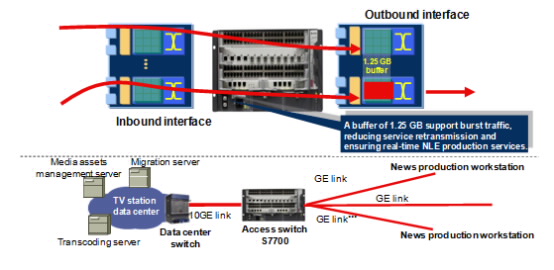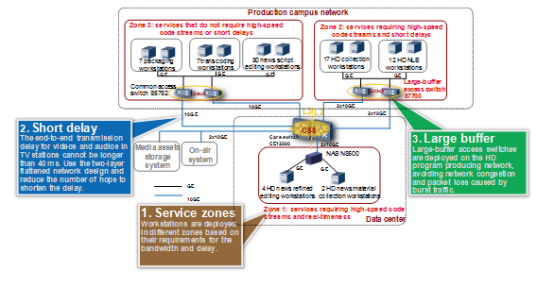With the increasingly rich program content, the audience requires clearer pictures. HD programs have become an inevitable trend. One of the priorities of the State Administration of Radio, Film, and Television (SARFT) is to enhance HD program production and promote HD TV development. TV stations of various levels are accelerating HD program construction and increasing investments in HD program production and playing. However, HD program production network construction faces the following challenges:
- Large burst video code streams are generated and transmitted from core switches to access switches during the dragging operation or viewing multiple videos simultaneously on HD non-linear editing (NLE) workstations. During the video stream transmission, the network bandwidth decreases, resulting in network congestion and frame loss.
- During the HD video production process, the video is played at the rate of 25 frames per second (FPS) with each frame being played for 40 ms, and the transmission duration from the time when an editing workstation sends an instruction to the time when the storage system returns data is shorter than 5 ms. Therefore, the delay must be as short as possible, near zero.
- Current program production networks of most TV stations adopt the FC+IP network. The construction cost and maintenance complexity of the FC network are higher than those of an Ethernet. IT personnel need to lower the network complexity and the operation and maintenance (O&M) costs when service requirements are met.
In the HD program editing and production process, large burst traffic is sent to downstream devices, which results in network congestion and frame loss. To resolve this problem, deploy large-buffer box switches that can dynamically allocate a 1.25 GB buffer at the access layer for the workstations and optimize the buffer and delay performance based on Huawei years of experience.
When burst traffic at the line rate of 10 Gbps and background traffic of 100 Mbps are sent to each workstation, the S7700 access switch with a buffer of 1.25 GB supports concurrent four-layer HD services on 78 workstations, meeting the requirement of three-layer burst traffic on 16 HD workstations.

Figure 1-1 Working mechanism of a large-buffer S7700 switch
The transmission delay of videos and audios must be shorter than or equal to 40 ms for TV stations, and different workstations have different delay requirements. The entire network adopts the two-layer flattened architecture. The packaging, transcoding, and news workstations are connected to access switches (S5700) through GE ports. The S5700 switches configured with iStack are connected to the core switches (CE12800) through 10GE ports. The collection and editing workstations are connected to the large-buffer switches (S7700) through GE ports. The S7700 switches configured with iStack are connected to the core switches through 10GE ports. The unified storage system N8500 is connected to the uplink core switches through two 10GE ports. The NLE workstations access the media assets storage system only by two hops. The end-to-end delay shorter than 40 ms is ensured for the NLE service using the load-balancing algorithm at the network side and file system parameter calibration at the storage side.

Figure 1-2 Logical architecture of Huawei HD program production solution for TV stations
Huawei adopts the zone-based design based on storage features, network features, and requirements of NLE workstations. Workstations are deployed in different zones based on their bandwidth and delay requirements.
| Zone
|
Network Layer
|
Workstation Deployment
|
Description
|
| Zone 1
|
Layer 2
|
4 HD news refined editing workstations and 2 HD news material collection workstations
|
The workstations are deployed in the same zone as the storage device and are directly connected to the storage device. Such deployment ensures real-time performance, 1.4 Gbps bandwidth, and uninterrupted services.
|
| Zone 2
|
Layer 2
|
3 HD collection workstations and 12 HD NLE workstations
|
The workstations are connected to large-buffer access switches at Layer 2. Such deployment supports a delay shorter than 5 ms and 4 Gbps bandwidth.
|
| Zone 3
|
Layer 3
|
80 news script editing workstations, 7 transcoding workstations, and 7 packaging workstations
|
The workstations are widely deployed on the network. Such deployment supports a delay shorter than 5 ms and 6 Gbps bandwidth.
|
Current program production networks of most TV stations adopt the FC+IP network. The construction cost and maintenance complexity of the FC network are higher than those of an Ethernet. IT technical personnel of the TV stations are looking for the balance point between the cost and performance. In addition to ensuring HD NLE services, Huawei provides an IP-based NAS and non-blocking switching network solution to help the customer lower the network complexity and O&M costs.
Huawei HD program production solution for TV stations not only ensures a large buffer, no packet loss, and short delays for program production and playing but also resolves the problem of high costs on construction and O&M of the FC+IP network.
- The 1.25 GB large buffer is designed at the access layer for NLE services, which prevents frame freezing of voices and images and frame loss.
The buffer and delay designs are optimized for HD NLE services for 60 workstations.
A large buffer can be dynamically allocated. Buffer sizes on ports are adjusted to lower the delay to shorter than 5 ms without packet loss.
- The zone-based service design, two-layer flattened network, and short-delay calibration ensure an end-to-end delay shorter than 40 ms for NLE services.
The network is divided into multiple zones based on service features of the packaging, transcoding, preliminary editing, and refined editing workstations, which ensures different bandwidth and access zones for the workstations.
Huawei adopts the two-layer flattened network and configures load balancing for network-side links and parameter calibration for storage-side file systems, ensuring that a delay on the link between the workstations and the storage system is shorter than 40 ms.
- The all-IP network simplifies the network architecture and lowers O&M costs by more than 50%.
- The FC network is migrated to the IP network. The all-IP network simplifies the network architecture, and unified network management simplifies O&M.


